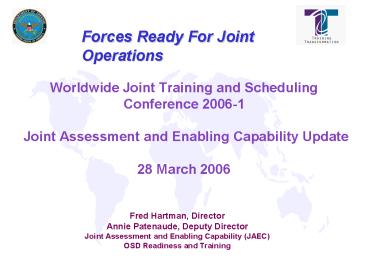Worldwide Joint Training and Scheduling Conference 20061 Joint Assessment and Enabling Capability Up - PowerPoint PPT Presentation
1 / 14
Title:
Worldwide Joint Training and Scheduling Conference 20061 Joint Assessment and Enabling Capability Up
Description:
Topic: Assessment within Joint Training System process ... Develop individuals and organizations that improvise and adapt to emerging crises ... – PowerPoint PPT presentation
Number of Views:143
Avg rating:3.0/5.0
Title: Worldwide Joint Training and Scheduling Conference 20061 Joint Assessment and Enabling Capability Up
1
Worldwide Joint Training and Scheduling
Conference 2006-1 Joint Assessment and
Enabling Capability Update28 March 2006
- Fred Hartman, Director
- Annie Patenaude, Deputy Director
- Joint Assessment and Enabling Capability (JAEC)
- OSD Readiness and Training
2
Agenda
- Overview of JAEC
- Assessment in Joint Training System
- 2005 T2 Block Assessment
- Metrics for the Future
- Way Ahead
3
T2 Management and Oversight
4
JAECs Place in Training Transformation
JNTC
Training Capabilities Analysis of Alternatives
T2 Integration
T2 Metrics Development
Collective
JAEC
Block Assessments
Joint Force Readiness
Unit Staff
TC AoA Implementation
Individual
T2 Adaptive Planning Integration
JKDDC
Defense Readiness Reporting System
5
Assessment Within the JTS
- Topic Assessment within Joint Training System
process - Status Assessment is least-developed of four
phases - Issue(s) Assessment structure, performance
metrics, enabling systems all being developed and
synchronized. - Impact Training assessments will affect the
other three phases of JTS as well as readiness
and decisions about resources. - Actions to Resolve Issue (Current/Planned)
OSD-JAEC partnering with Joint Staff/J7, JFCOM,
Services, and other Stakeholders to realize
fully-functional and fully-supporting Assessments
6
Block Assessment
- Topic Assessment of Training Transformation
- Status 2005 baseline assessment complete and
published - Issue(s) 2005 assessment used metrics that were
available, not always optimum. Ad hoc data
collection was time-consuming for JNTC and JKDDC.
- Impact Analysts spent time gathering
information, not analyzing it. Positive measures
need to be taken to prevent a repeat for 2007,
but more importantly to put in place an
overarching framework to assess the effect of
Joint training on force readiness. - Actions to Resolve Issue (Current/Planned) JAEC
leading effort to synchronize efforts of
stakeholders (e.g., 27 March working group). T2
Assessment Plan for 2007 in development.
7
T2 Charge for Block Assessment
- The purpose of the Block Assessment
- Assess Joint training capabilities, T2
integration and management - Provide feedback concerning how forces are
trained in T2 to meet operational needs, now and
in the future - Focus assessments on enhancing T2 Joint training
initiatives - Enable continuous transformation of DoD
- Source DoD T2 Implementation Plan, 9 June 2004
- Address three questions
- How is T2 enabling the readiness of our Joint
forces to meet operational needs? - How can T2 programs be better focused on meeting
current and future operational needs? - How can T2 management be made more effective?
Collaborative Process Across Training Community
8
Block Assessment Methodology for 2005
Supplemented By Case Study Technique
Attributes of Joint Training
T2 Objectives
- Strengthen Joint operations by preparing forces
for new warfighting concepts - Continuously improve Joint force readiness by
aligning Joint education and training
capabilities and resources with combatant command
needs - Develop individuals and organizations that think
Joint intuitively - Develop individuals and organizations that
improvise and adapt to emerging crises - Achieve unity of effort from a diversity of means
- Prepare forces for new war fighting concepts and
capabilities - Develop individuals and organizations that
improvise and adapt to emerging challenges
- Focus on Right Skills, Tasks,
- Learning
- Train the Right Audience
- Provide Flexible, Adaptive, Timely Training
- Efficiency
9
2005 Assessment Outcome Metrics
10
2005 Assessment Process Metrics
11
2005 Assessment Metrics Process Outcome Metrics
12
Candidate Long-Term Metrics
- Flexible/Adaptive/Timely Training
- Amount and timeliness of lessons learned feedback
- Time to fill emerging joint training gaps
- Pre-deployment training at the right time for
individual and collective training - Efficiency
- Cost per participant (collective and individual
training) - Percent of training that is conducted at home
station vice other (support and participant)
- Right Skills/Tasks/Learning
- Percent COCOM JMETs trained in joint exercises
- Percent of JMETL missions for which assigned
forces are fully trained, partially trained, or
untrained - Training outcomes
- Effectiveness of feedback systems
- Right Audience
- Number of participants using JKDDC and JGTC
resources - Number of programs accredited and/or certified
- Extent of Reserve Component, Interagency, and
International participation in joint training
These are a starting pointnot carved in stone
13
What We Can Do Better T2 Management Actions
- Integrated approach for conducting Individual and
Collective training - Manage personnel aspects of training to track
experience, education, and training - Promote wider use of the Joint Training System
- Other management issues
- JKDDC move to JFCOM site
- Ensure MRXs scheduled close to deployment
- Train DoD forces with interagency, multinational,
etc. to maximize interoperability - Follow-up with TC AoA recommendations
14
Way Ahead
- For T2
- Train individuals and units in adaptability
- Make training more capable of quickly responding
to changing missions and lessons learned - Develop assessment framework with common metrics
- Incorporate 2005 assessment feedback into T2
programs - Provide data collection plan within JTS and JTIMS
- Continue to address critical TC AoA joint
training deficiencies (gaps) - Incorporate resource analysis process
- For T2 Assessment
- Prepare JMOs for future cost, schedule and
performance assessments - Focus data collection for Services and COCOMs
through JTS and JTIMS - Provide metrics development process for T2
exercises and individual training - Institutionalize feedback from Senior Mentors,
Staff Assistance Visits, and lessons learned































